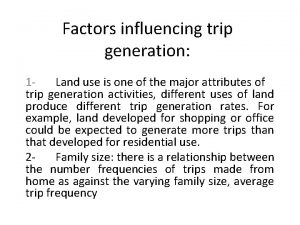Factors Influencing Communication 1 Factors Influencing Communication Process























- Slides: 23

Factors Influencing Communication 1

Factors Influencing Communication Process 1. 2. 3. 4. 5. 6. 7. 8. Development & gender Sociocultural characteristics Values and perception Personal space and territoriality Roles and relationships Environment Congruence Attitudes

1. a. Development • Language and communication skills develop through stages • Communication techniques for children o Play o Draw, paint, sculpt o Storytelling, word games o Read books; watch movies, videos o Write

1. b. Gender • Females and males communicate differently from early age Ø Boys establish independence, negotiate status Ø Girls seek confirmation, intimacy

2. Sociocultural Characteristics A. Culture B. Education C. Economic level

a. Cultural Context • Because behavior is learned, nonverbal communication varies from culture to culture. • For example, the messages communicated by touch and eye contact depend to a great extent on one’s cultural context. 6

3. Values and Perception • • Values standards that influence behavior Perceptions personal view of an event Unique personality traits, values, experiences Validate

Perception • Perception is a person’s sensing and understanding of the world. • Perception of an event or situation is unique in that it varies from person to person. • “Perceptions are influenced by our culture, socialization, education, and experience” (Ward-Collins, 1998, p. 29). • • They help a person determine the meaning of the words and the content of the messages being communicated. • It is important for the listener to confirm what she thinks she has heard, because interpretation of the message depends upon the hearer’s perception of the message 8

4. Personal Space • Defined as distance people prefer in interactions with others • Proxemics o Intimate distance frequently used by nurses o Personal distance less overwhelming o Social distance increased eye contact • Out of reach for touch o Public distance

Space and Distance • Proxemics is the study of the distance between people and objects. • Each person has an invisible buffer zone or personal space. • Culturally defined, this boundary alerts a person as to how close another can comfortably approach. • Invasion of personal space produces discomfort, anxiety, and the fight-or-flight response. • The nurse respects the client’s personal space in several ways, such as not touching or moving the client’s possessions unless necessary. 10

Figure 36 -5 Personal space influences communication in social and professional interactions. Encroachment into another individual’s personal space creates tension.

Territoriality • Space and things o Individual considers as belonging to self o Knock before entering space • May be visible o Curtains around bed unit o Walls of private room o Removing chair to use at another bed

5. Roles and Relationships • • • Between sender and receiver First meeting versus developed relationship Informal with colleagues Formal with administrators Length of relationship

6. Environment • Can facilitate effective communication • Key factors o Comfort o Privacy

7. Congruence • Congruence o Verbal and nonverbal aspects match o Seen by nurse and clients • Incongruence o Sender’s true meaning in body language • Improving nonverbal communication o Relax; use gestures judiciously o Practice; get feedback on nonverbal

8. Attitudes • Interpersonal attitudes o Attitudes convey beliefs, thoughts, feelings o Caring, warmth, respect, acceptance • Facilitate communication o Condescension, lack of interest, coldness • Inhibit communication o Effective nursing communication • Significantly related to client satisfaction o Respect

Time • The study of the effects of time on the communication process is referred to as chronemics. • The amount of time spent in communicating depends on the client’s needs. • Some clients will require more of the nurse’s time than others. • The client who is seriously ill or nontrusting may respond better to brief, frequent contact than to prolonged, infrequent contact. 17

9. Time • If the nurse is hurried during the interaction with the client, a nonverbal message of impatience may be transmitted. • Keeping clients waiting conveys a message that they are unimportant. • On the other hand, the nurse who is prompt and who allows time for the client to talk communicates nonverbally, “You are important to me, ” and “I value you as a person. ” • The whole communication process is influenced by time. For example, the same message received at 3: 00 AM will be perceived and responded to differently at 3: 00 PM. 18

Levels of communication 1. Intrapersonal Level • Intrapersonal communication is the messages one sends to oneself, including self-talk, or communication with oneself. • A person receiving internal or external messages organizes, interprets, and assigns meaning to the messages. • The result of this process is the individual’s unique way of perceiving. • The message of the speaker may differ from that heard by the receiver because of the intrapersonal communication of each. • Also, self-talk can interfere with attention to others and cause much to be missed during interpersonal exchanges. 19

2. Interpersonal Level • Interpersonal communication is the process that occurs between two people either in face-to-face encounters, over the telephone, or through other communication media. • Interpersonal communication builds on the intrapersonal level in that each person communicating must communicate with the self in order to communicate with others. • An important outcome of interpersonal communication is the development of an interpersonal relationship • Interpersonal skills are essential competencies for nurses. 20

3. Group Communication Level • Group communication occurs when three or more people meet in face-to-face encounters or through another communication medium, such as a conference call. • This level of communication is complex because of both the number of people communicating intra-personally and interpersonally and the combinations of the people involved. 4. Mass Communication When speaking to a large audience that cannot be gathered in one place 21

• The study of the events that take place during group interaction is called group dynamics. • The dynamics of any group can and will influence the productivity of the group. • Nurses deal with groups constantly as they interact with families of clients, treatment teams, therapy groups, and committees within their health care settings 22

Barriers to Communication 1. 2. 3. 4. 5. 6. Stereotyping Agreeing and disagreeing Being defensive Challenging Probing Testing 7. 8. 9. 10. 11. Rejecting Changing topics Unwarranted reassurance Passing judgment Giving common advice
 Factor that
Factor that Dynamic approach to personality
Dynamic approach to personality Oxidation weathering
Oxidation weathering Factors affecting wages and salary administration
Factors affecting wages and salary administration Physical factors influencing agriculture
Physical factors influencing agriculture Vertical component of projectile motion
Vertical component of projectile motion Factors influencing contemporary nursing practice
Factors influencing contemporary nursing practice Factors influencing trip attraction
Factors influencing trip attraction Pricing policies
Pricing policies A model of destination image formation
A model of destination image formation Factors influencing maternal health
Factors influencing maternal health Systemic factors affecting wound healing
Systemic factors affecting wound healing Factors influencing faculty staff relationship
Factors influencing faculty staff relationship Factors affecting layout
Factors affecting layout Role of network design in supply chain
Role of network design in supply chain Physical factors influencing agriculture
Physical factors influencing agriculture Factors affecting consensus
Factors affecting consensus Types of chemical weathering
Types of chemical weathering Factors influencing distribution network
Factors influencing distribution network Factors affecting oxygenation slideshare
Factors affecting oxygenation slideshare Physical factors influencing agriculture
Physical factors influencing agriculture Simple carburetor diagram
Simple carburetor diagram Factors influencing t&d
Factors influencing t&d Differentiated learning theories
Differentiated learning theories













































